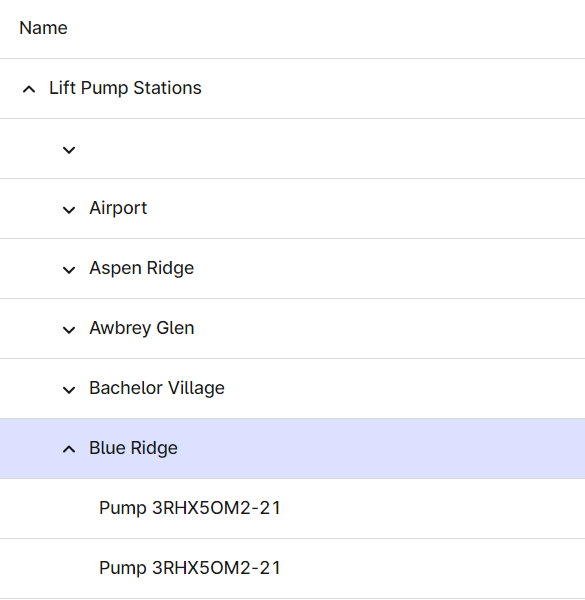Asset Hierarchy Source¶
Prerequisite:
- Access to a CDF Project.
- Know how to install and setup Python.
- Launch a Python notebook.
In this tutorial, we will show you how to migrate an asset hierarchy to a data model representing the same hierarchy in CDF.
This tutorial is also a good demonstration of the width of capabilities for neat, going from extracting data, creating a data model, export the data model, and load the data.
Extract Data from Asset Hierarchy¶
We will start by extracting the data from an existing asset hierarchy.
The example we will use in this tutorial is an asset hierarchy for pumps, shown below in CDF's classic Data Exploration

from cognite.neat import NeatSession, get_cognite_client
We start by instansiating a new NeatSession
client = get_cognite_client(".env")
Found .env file in repository root. Loaded variables from .env file.
neat = NeatSession(client, storage="memory")
neat
Neat Engine 2.0.3 loaded.
neat.read.cdf.classic.graph(root_asset_external_id="lift_pump_stations:root")
Extracting Asset relationships: 100%|███████████████████████████████████████████████████████████████████████████████████████████████████████████████████████████████████████████████████████| 1/1 [00:00<00:00, 13.19it/s] Extracting data sets: 100%|█████████████████████████████████████████████████████████████████████████████████████████████████████████████████████████████████████████████████████████████████| 1/1 [00:00<00:00, 17.89it/s]
Success: Read Classic Graph
neat
Data Model
| type | Logical Data Model |
|---|---|
| intended for | Information Architect |
| name | ClassicDataModel |
| external_id | ClassicDataModel |
| version | v1 |
| classes | 9 |
| properties | 71 |
Instances
Overview:
- 1 named graphs
- Total of 2 unique types
- 246 instances in default graph
default graph:
| Type | Occurrence | |
|---|---|---|
| 0 | ClassicAsset | 245 |
| 1 | ClassicDataSet | 1 |
Provenance:
- Initialize graph store as Memory
- Extracted triples to named graph urn:x-rdflib:default using ClassicGraphExtractor
- Extracted triples to named graph urn:x-rdflib:default using ClassicGraphExtractor
- Extracted triples to named graph urn:x-rdflib:default using ClassicGraphExtractor
- Extracted triples to named graph urn:x-rdflib:default using ClassicGraphExtractor
- Extracted triples to named graph urn:x-rdflib:default using ClassicGraphExtractor
- Extracted triples to named graph urn:x-rdflib:default using ClassicGraphExtractor
- Extracted triples to named graph urn:x-rdflib:default using ClassicGraphExtractor
- Extracted triples to named graph urn:x-rdflib:default using ClassicGraphExtractor
- Added dict to urn:x-rdflib:default named graph
- Upsert prefixes to the name graph {named_graph}
- ConvertLiteral is a transformer that improve data typing of a literal value.
- Converts a literal value to new entity
Exporting Data Model¶
Lets export our newly created data model to CDF. First, we need to convert it to an phsycial format.
neat.convert()
Rules converted to dms.
Success: NEAT(verified,logical,neat_space,ClassicDataModel,v1) → NEAT(verified,physical,neat_space,ClassicDataModel,v1)
neat
Data Model
| aspect | physical |
|---|---|
| intended for | DMS Architect |
| name | ClassicDataModel |
| space | neat_space |
| external_id | ClassicDataModel |
| version | v1 |
| views | 9 |
| containers | 9 |
| properties | 69 |
Instances
Overview:
- 1 named graphs
- Total of 2 unique types
- 246 instances in default graph
default graph:
| Type | Occurrence | |
|---|---|---|
| 0 | ClassicAsset | 245 |
| 1 | ClassicDataSet | 1 |
Provenance:
- Initialize graph store as Memory
- Extracted triples to named graph urn:x-rdflib:default using ClassicGraphExtractor
- Extracted triples to named graph urn:x-rdflib:default using ClassicGraphExtractor
- Extracted triples to named graph urn:x-rdflib:default using ClassicGraphExtractor
- Extracted triples to named graph urn:x-rdflib:default using ClassicGraphExtractor
- Extracted triples to named graph urn:x-rdflib:default using ClassicGraphExtractor
- Extracted triples to named graph urn:x-rdflib:default using ClassicGraphExtractor
- Extracted triples to named graph urn:x-rdflib:default using ClassicGraphExtractor
- Extracted triples to named graph urn:x-rdflib:default using ClassicGraphExtractor
- Added dict to urn:x-rdflib:default named graph
- Upsert prefixes to the name graph {named_graph}
- ConvertLiteral is a transformer that improve data typing of a literal value.
- Converts a literal value to new entity
- Added dict to urn:x-rdflib:default named graph
- Upsert prefixes to the name graph {named_graph}
neat.to.cdf.data_model(existing="recreate")
You can inspect the details with the .inspect.outcome.data_model(...) method.
| name | unchanged | created | deleted | issues | |
|---|---|---|---|---|---|
| 0 | spaces | 1 | 0 | 0 | 0 |
| 1 | containers | 0 | 9 | 9 | 0 |
| 2 | views | 0 | 9 | 9 | 0 |
| 3 | data_models | 0 | 1 | 1 | 1 |
| 4 | nodes | 0 | 0 | 0 | 0 |
We see the data model was succesfully created.
Populating Data Model¶
As the data model is ready, we can move the instances to CDF
neat.to.cdf.instances()
You can inspect the details with the .inspect.outcome.instances(...) method.
| name | created | changed | |
|---|---|---|---|
| 0 | ClassicAsset | 245 | 0 |
| 1 | ClassicDataSet | 0 | 1 |
As we see from the result above, Neat has created 245 Assets in the new data model.
Results¶
Final Remarks¶
- In this tutorial, we used the in-memory version of the Neat store. This works well for small examples, like the toy example here, but for larger asset hierarchies we likely need to use a faster triple store such as
GraphDBorOxigraph. These are also available in Neat, but require extra dependencies. - This can be considered the first step of a full migration. At least two related problems may remain
- First, we might want to infer a more specific type than
Asset, for example,PumpandLiftStation. This means adding information that is not explicitly set in the existing Asset Hierarchy. The type might be implicitly defined from the level in the hierarchy, or for example, the external ID of the asset. See part 2 for an example of how to add type in the migration process. - We might want to map the inferred model onto an existing data model. It this case the existing model would be an
EnterpriseModeland the inferred model we obtained here would be aSourcemodel.
- First, we might want to infer a more specific type than

